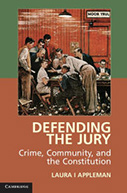Defending the Jury: Crime, Community, and the Constitution

Author: Laura I. Appleman
Publisher: New York: Cambridge University Press, 2015. 241p.
Reviewer: Stephanos Bibas | May 2016
In colonial America, criminal justice was a morality play, a form of educational social theater. Hardly anyone had formal legal training, so everything was run by laymen. Victims prosecuted their own cases, defendants defended themselves pro se, and juries sat in judgment. With no lawyers to run the system, there were almost no technical rules of evidence or procedure. Guilt and punishment were matters of common-sense moral judgment, reflecting the will of the people. The point of criminal justice was to condemn crime, blame criminals, reinforce the community’s moral code and social cohesion, and then reintegrate the wrongdoer after he had paid his debt to society and the victim. In order to fulfill this role, criminal justice was by design a very public affair. Everyone had his day in court and would quite literally see justice done. The centerpiece of this morality play was of course the jury trial. Both the original Constitution (in Article III) and the Bill of Rights (in the Sixth Amendment) guaranteed criminal jury trials as a cornerstone of democratic self-government.
Over the course of the nineteenth and twentieth centuries, lawyers steadily displaced laymen. Prosecutors took over from victims, defense lawyers silenced their clients and scripted their few remarks. With the connivance of judges, the two sides developed plea bargaining as a faster, cheaper way to dispose of cases. As any economist can tell you, consensual market transactions as a rule make both sides better off. Judges clear their busy dockets; prosecutors do the same and guarantee certainty of conviction and punishment; defense lawyers cap their clients’ exposure and avoid embarrassing defeats at trial. Criminal justice professionals benefit from the plea-bargaining assembly line, are used to it, and see it as sensible and inevitable.
But criminal law is not just private deal-making, but public justice. In econo-speak, colonial criminal justice created positive externalities, but today’s system imposes negative externalities. Victims, some defendants, and the public are understandably suspicious of commodifying criminal justice and trading it like a sack of potatoes. They have been shut out or silenced and are understandably suspicious of the deals cut via hurried conversations in courthouse hallways. Jury trials linger as anomalous historical relics, resolving only a few percent of all cases.
This plea-bargaining assembly line is efficient in a narrow, economic sense of minimizing cost and maximizing speed. But viewed more broadly, the costs are considerable. Victims and defendants have lost their day in court. Community members have lost their say and their central role in democratic self-government. And criminal justice has drifted from a popular, cathartic morality play into an amoral carceral state driven by special interests such as prison-guard unions.
Over the last two decades, however, the Supreme Court has gestured toward reviving the Sixth Amendment jury guarantee. In Apprendi v. New Jersey, 530 U.S. 466 (2000), Blakely v. Washington, 542 U.S. 296 (2004), and their progeny, a bare majority of the Court has insisted that, absent an admission by a defendant, most facts that increase defendants’ minimum or maximum sentences must be proved to a jury beyond a reasonable doubt. An unusual coalition of Justices formed the majorities in these cases: both more liberal Justices solicitous of defendants’ rights and more conservative Justices concerned with preserving the jury’s popular check upon government officials. But the Apprendi / Blakely Court never really laid out a punishment philosophy that explains the need for juries.
Laura Appleman’s new book steps into the breach. In Defending the Jury, she seeks to place the spirit of Apprendi and Blakely in historical context, to ground it in punishment theory and democracy, and to extend it to a much wider array of criminal justice decisions. Her review of the history (in pt. I) emphasizes Akhil Amar’s point that the jury right belongs not just to defendants but to the community, as underscored by the emphasis on local vicinage and a public trial. Our anachronistic emphasis on the zero-sum game between individual defendants and the state obscures the broader importance of juries to democratic self-government. As Appleman notes, one cannot reduce the community to the state that purports to speak for it (p.155). Efficiency does not justify bypassing democracy.
This institution of the criminal jury serves the substantive justification for punishment. Community participation matters because the job of the criminal law is to express and reinforce the community’s moral code, restore victims, condemn blameworthy wrongs, and reintegrate wrongdoers into the community. At the root of constitutional criminal justice, Appleman argues (in pt. II), is punishment grounded in expressive, restorative retribution. She follows (at pp. 56-68) Paul Robinson’s emphasis on empirical desert (reflecting the community’s moral intuitions), Jean Hampton’s argument that punishment must restore the victim’s dignity, and Steve Garvey’s endorsement of punishment as atonement. Though she does not draw the connection, her argument dovetails well with John Stinneford’s reading of the Eighth Amendment as forbidding punishments that exceed retributive desert. Rethinking Proportionality Under the Cruel and Unusual Punishment’s Clause, 97 Va. L. Rev. 899, 962-66 (2011). The difficulty, as she acknowledges (in ch. 5), is that identifying the relevant community is far harder in our mobile, far-flung, heterogeneous modern society than it was in the colonial era of tight little villages.
Appleman’s book is of a piece with a more recent scholarly trend toward democratizing and localizing criminal justice. The conventional wisdom of scholars (and often judges) long favored centralized bureaucratic elites over democratic control. Constitutional law has been preoccupied with the countermajoritarian difficulty, viewing judges as saviors or bulwarks against popular idiocy. Criminal law has sought to replace the common law’s blame-laden concepts with the Model Penal Code’s clinical detachment. Criminal procedure has exalted judges as bulwarks against voters’ and jurors’ supposed anger, bigotry, and punitiveness. (This jaundiced view of the people does not square with the evidence, as Paul Robinson and others have shown.)
But elite reformers’ efforts to soften and equalize criminal justice by insulating it from the public have backfired. Racial disparities are hardly better than they were decades ago. Agency costs pervade the criminal justice system, skewing lawyers’ decisions. Professionals grow jaded “and may be more interested in uniformity (or in some cases, reelection) than individual justice” (p.115). Efforts to exclude the public have often misfired, resulting in three-strikes laws, mandatory minima, and ratcheting sentences upward. Yet many reformers insist on doubling down on these failed solutions.
The opposite extreme of populism is no better. It does no good to dream about dynamiting the entire plea-bargaining edifice and going back to full-blown criminal jury trials for every single case. Not a single member of the Supreme Court shows any interest in revisiting the validity of plea bargaining, even though it conflicts with the text of Article III and historical practice. Nor could our system handle the enormous volume of cases, particularly given the elaborate trial procedures and rules of evidence that have grown up over the last two centuries. Going back to the eighteenth century is a fantasy, one that Appleman rightly rejects.
Instead, Appleman seeks to navigate the gap between ideal and reality, trying to fit jury-like bodies into twenty-first-century institutions. She imagines bail juries that would pass on issues of community safety (ch. 6). She would have plea juries listen to and scrutinize defendants’ allocutions and proposed sentences (ch. 7), an idea I have endorsed as well. She would also eliminate bench trials (ch. 8). Appleman suggests ways to include jury-like bodies in preparing pre-sentencing reports, probation, parole, supervised release, fines, and restitution (chs. 9-10). And she cautiously endorses jury nullification while raising concerns about victims’ rights (ch. 11). As Appleman rightly recognizes, however, one can hardly be optimistic about the prospects for change. The practical barriers are daunting.
Although I agree with much of what Appleman says about the prospects for change, I think she could do more to engage with counterarguments and practical concerns, such as caseload pressures, funding, bias, and how to weave the legitimate roles of expertise and detachment together with popular input. And I could certainly quibble with some of Appleman’s specifics, such as her false dichotomy between victims’ rights and the community’s interest in punishment. Victim participation hardly “throws a wrench into the original procedures of criminal justice as they were conceived in this nation almost 250 years ago” (p. 217). On the contrary, historically, victims spoke at length when prosecuting their own cases and telling juries their side of the story, before professional prosecutors supplanted and silenced them.
Nor need victim participation violate the community’s sense of justice. As Robinson’s empirical work shows, many citizens’ punishment intuitions are sensitive to whether wrongdoers have paid compensation or apologized to victims, and sometimes even to whether victims want less or more punishment. Paul H. Robinson et al., Extralegal Punishment Factors, 65 Vand. L. Rev. 737, 782 tbl. 5 (2012). Though Robinson did not test for it, factual information provided by victims about the harms they suffered would likely matter even more to jurors. Appleman’s argument could easily embrace such victim input, so long as it is filtered through a sentencing jury’s decision to weigh victim impact in the context of all relevant factors, including harm to the community and the community’s views on punishment. Sentencing juries could thus be trusted to tamp down victims’ idiosyncratic calls for harshness or leniency.
These quibbles should not obscure the bigger picture. Appleman’s work is of a piece with the exciting movement toward democratic criminal justice reform. Insular elitism has failed. Appleman’s effort to take us back to the future is ambitious and, like all ambitious efforts, would not prove easy to implement. But the effort is nevertheless an important one, to restore the central role of popular moral judgment and democratic accountability.
Stephanos Bibas is a professor of law and criminology at the University of Pennsylvania and the author of The Machinery of Criminal Justice (Oxford 2012) and Rebooting Justice (Encounter Books forthcoming 2017) (with Benjamin H. Barton).


